MFD Touch - Bar Graph Screen
You can select the BAR GRAPH screen from the ADD/REMOVE screen. It contains a bar graph gauge with 3 supporting numerical elements. The units used are depending on what is selected in the Settings menu.
.png?revision=1)
Bar Graph Element
The Bar Graph gauge element is located on the bottom of the screen, it provides a visual representation of a selected parameter (speed by default).
_Red_Highlight.png?revision=1)
You can configure the gauge by pressing and holding or double-tapping on it. This will open up the BAR GRAPH SETTINGS menu.
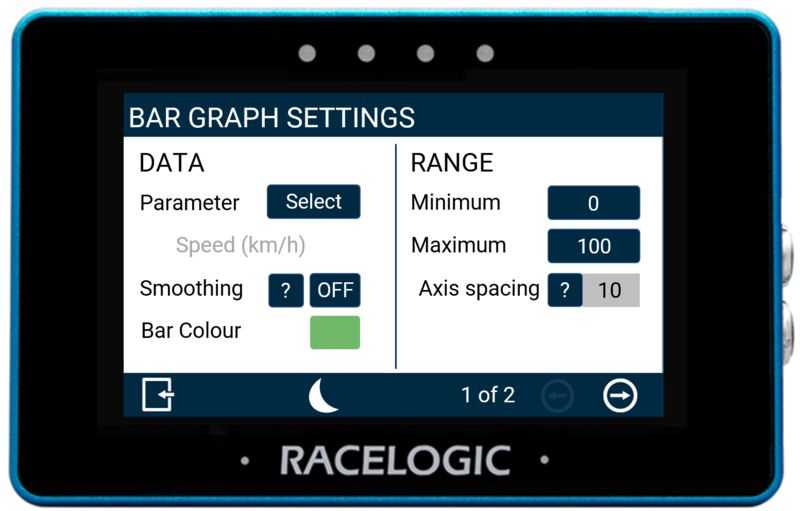 Screen 1 |
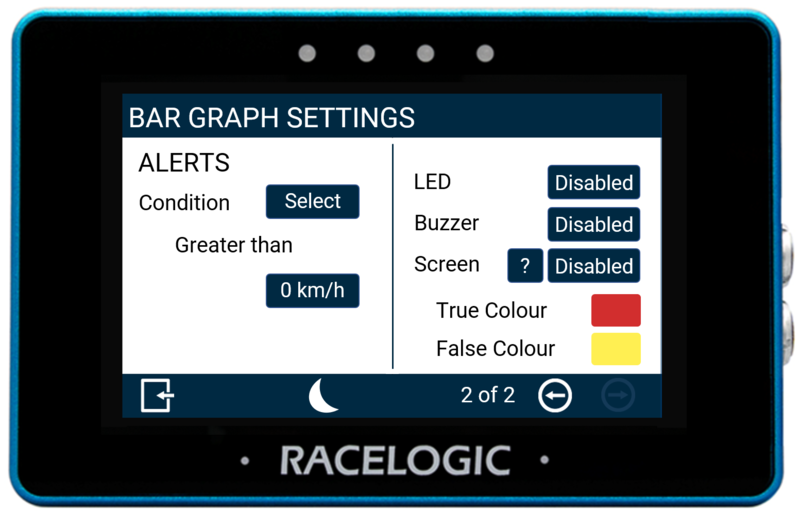 Screen 2 |
There are 2 Bar Graph settings screens available: DATA/RANGE and ALERTS. You can toggle between them by pressing the Forward or Back arrows on the bottom right of the screen or by swiping left or right. You can change the settings by pressing the corresponding button next to an option.
To return to the parameter screen, press the Exit button in the bottom left corner.
Note: If you have an SD card inserted, it will remember the settings values after each power cycle.
Data
Parameter
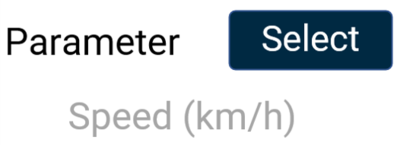
The Bar Graph gauge parameter is set as speed by default, but you can change it by pressing the Select button to open the parameter list. You can assign any data parameter that is available from the connected VBOX to the Bar Graph (apart from UTC Time, Longitude, Latitude, Solution Type, Trigger, Filename, Logging Status, Memory Used, and
KF Status).
Note: The currently selected parameter data source is highlighted in blue and the actual parameter used is displayed in grey within the options list.
-_highlighted_option_750px.png?revision=1) Data Source Menu |
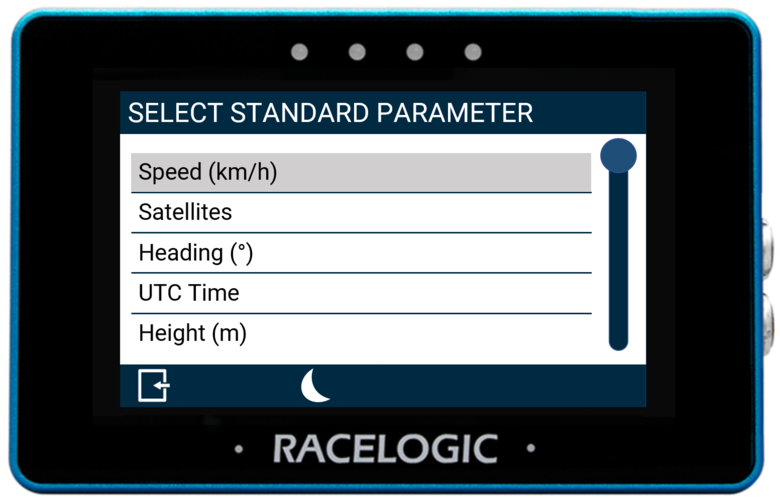 Standard Parameter Menu |
Use the scroll bar on the right-hand side of the selection screen to navigate through the options and press the desired parameter to confirm your selection.
To return to the settings screen press the Exit button in the bottom left corner.
You can find a list of the available parameters here.
Note: If a previously selected CAN channel parameter is no longer available, the values for that parameter will display as zero or nil. The parameter reference name will be greyed out and 'MISSING PARAMETER' will flash in the header of the screen.
Smoothing

If required, you can have the Bar Graph data smoothed. The input value determines the number of previous data samples used to smooth the displayed data. It does not affect any of the performance results or the logged data of the connected unit.
To enable smoothing, press the current value (off by default) and use the presented keypad to enter the number of previous data samples you would like to use for the display smoothing.
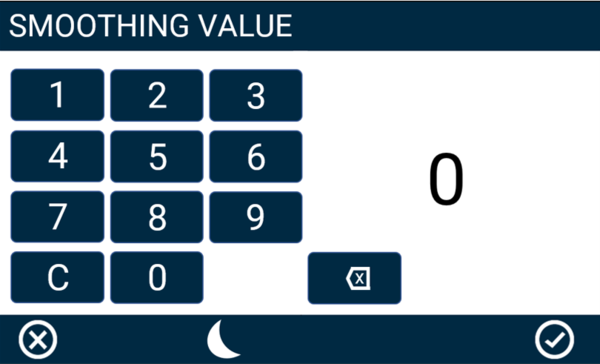
Smoothing Value Keypad Example
Save your selected values by pressing the Confirm button in the bottom right corner of the screen. Press the Cancel button in the bottom left corner of the screen to return to the Settings screen without saving.
Notes:
- The maximum input value is 99.
- Smoothing can introduce a slight delay to the displayed value.
Bar Colour

To change the colour of the bar in the Bar Graph, press the current colour (green by default) and use the presented RGB sliders to define your new colour. The area to the left of the sliders provides a colour preview.
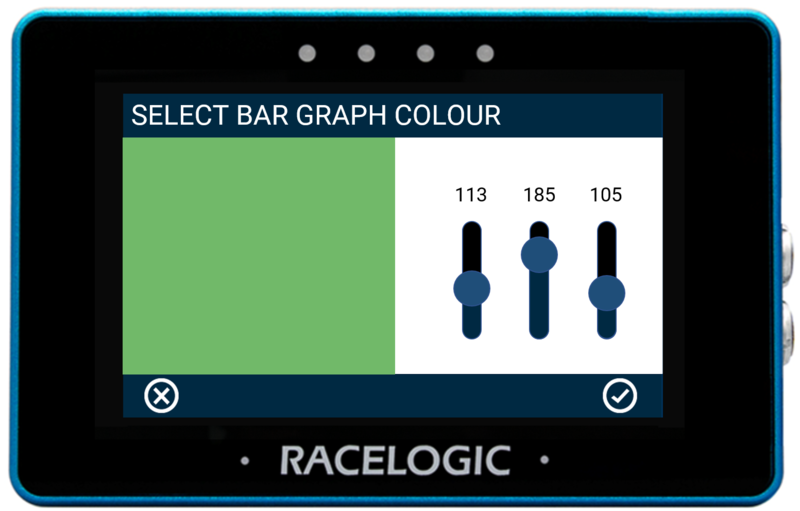
To save your colour selection, press the Confirm button in the bottom right corner. Press the Cancel button in the bottom left corner to return to the Settings screen without saving.
Note: If you enable Night Mode, it will reset user-defined bar colours.
Range
Minimum/Maximum
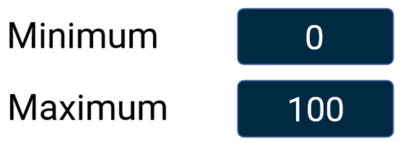
Define the minimum and maximum range values for the Bar Graph element's axes. Press the value boxes and use the presented keypad to define the required values, set as 0 and 100 by default.
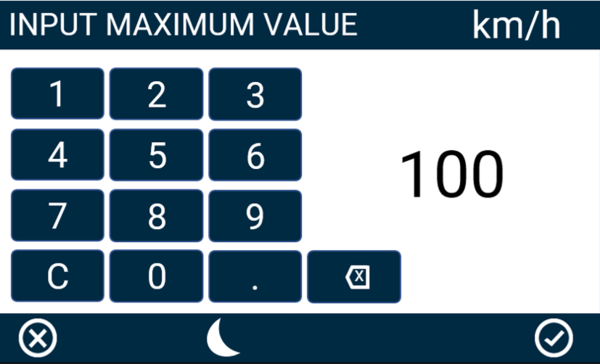
Maximum Range Keypad Example
Save your selected values by pressing the Confirm button in the bottom right corner of the screen. Press the Cancel button in the bottom left corner of the screen to return to the Settings screen without saving.
Notes:
- The maximum input value is 99999.
- The minimum input value is -99999 (when a signed parameter is selected, otherwise 0).
- One decimal place resolution available.
Axis Spacing

The Axis Spacing value tells you how much spacing there is between each gauge increment marker. The value will change depending on the Minimum/Maximum Range Value.
Alerts
Condition
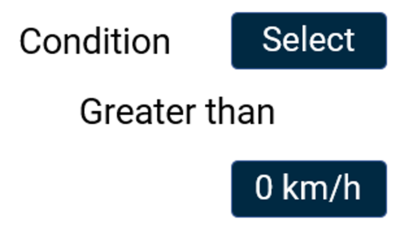
This option allows you to define an alert condition. Press the Select button to cycle through the available conditions: Equal To, Not Equal To, Less Than, Less Than or Equal To, Greater Than (default), Greater Than or Equal To, Between, or Not Between. You can then define the alert condition value(s) by pressing the value box and using the presented keypad.
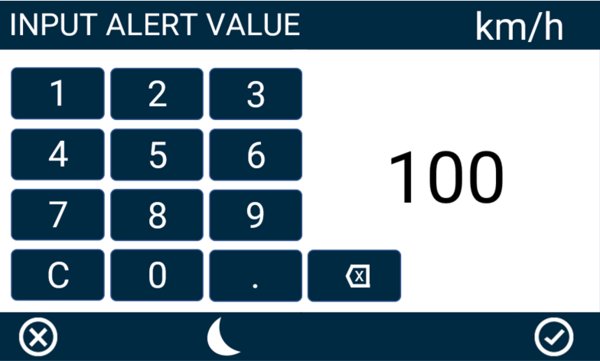
Alert Value Keypad Example
Save your selected values by pressing the Confirm button in the bottom right corner of the screen. Press the Cancel button in the bottom left corner of the screen to return to the Settings screen without saving.
Note: The setting will be greyed out and disabled if the configured numerical parameter is UTC Time, Longitude or Latitude.
LED

Select to enable a solid or flashing visual alert when the Defined Alert Condition is met. Press the button to cycle through the options. The device will preview the setting with the 4 red LEDs across the top of the unit.
Buzzer

Select to enable an audible alert when the Defined Alert Condition is met. The MFD Touch will beep when this setting is enabled.
Screen
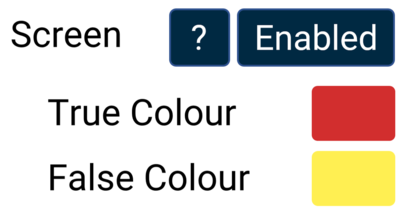
It is possible to enable a screen target zone in relation to the Defined Alert Condition. If the value has yet to be achieved, the 'False Colour' will appear in the target zone. When the value is achieved, the 'True Colour' will appear in the target zone.
To change the True and False target zone alert colours, press the current colours (yellow and red by default) and use the presented RGB sliders to define your new colours. The area to the left of the sliders provides a colour preview.
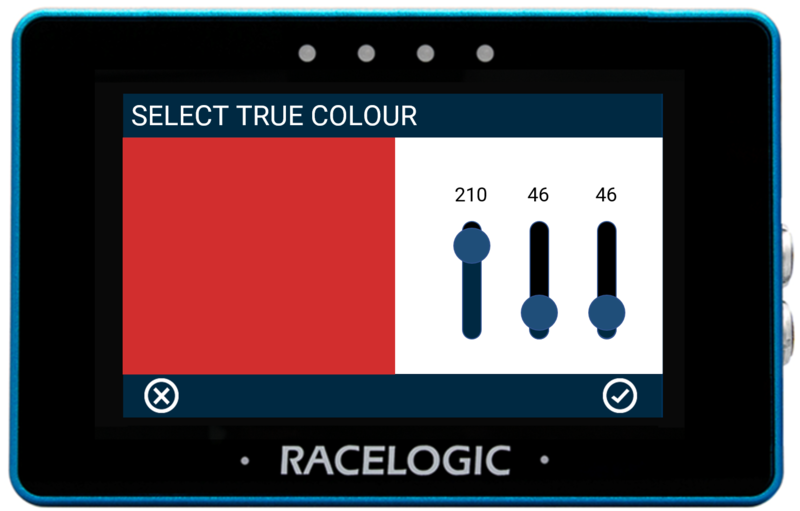 True Colour Configuration Example |
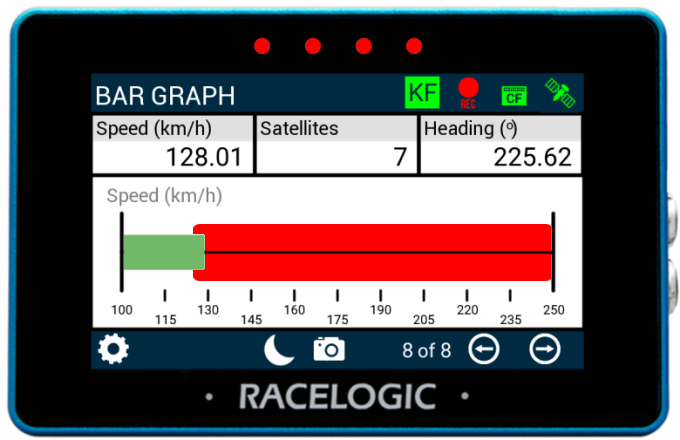 Screen Alert Example |
To save your colour selection, press the Confirm button in the bottom right corner of the screen. Press the Cancel button in the bottom left corner of the screen, to return to the Settings screen without saving.
Note: If you enable Night Mode, it will reset user-defined alert colours.
Numerical Elements
The 3 numerical elements are located on the top of the screen and include Speed, Satellites and Heading parameters by default.
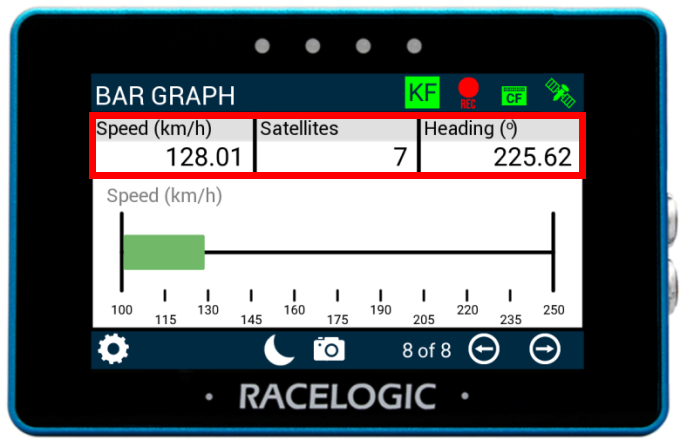
You can configure each parameter by pressing and holding or double-tapping the existing parameter area. This will open up the NUMERICAL SETTINGS menu.
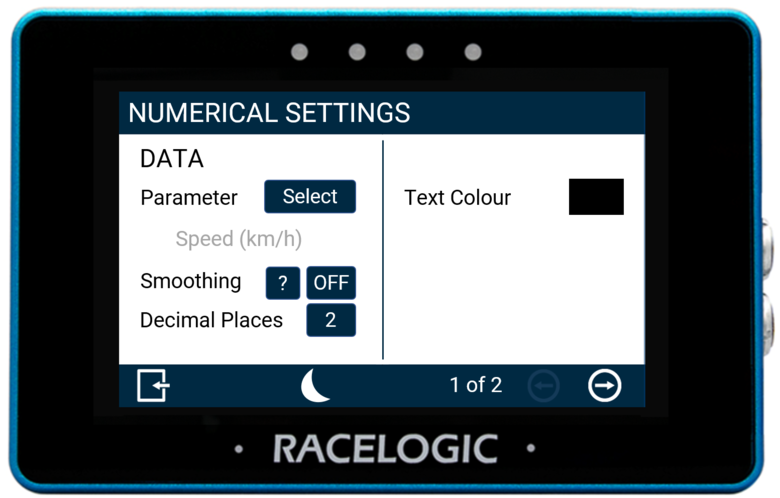 Screen 1 |
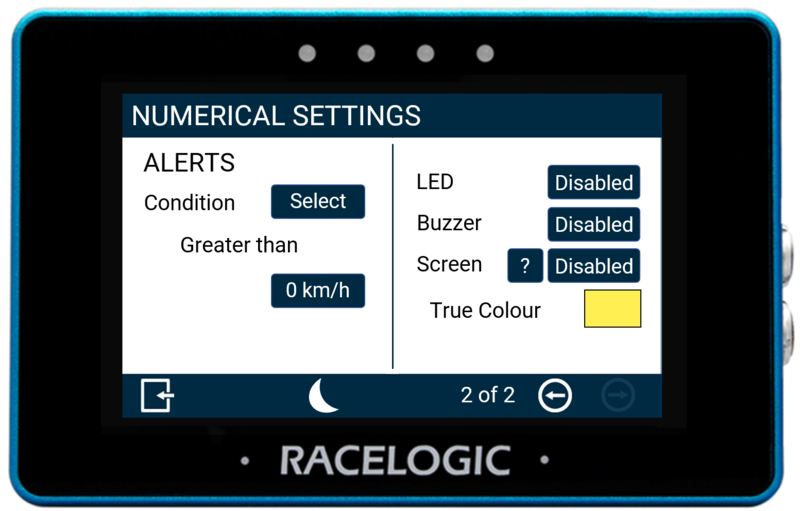 Screen 2 |
There are 2 numerical settings screens available: DATA and ALERTS. You can toggle between these screens by pressing the Forward or Back arrows on the bottom right of the screen or by swiping left or right. You can change the settings by pressing the corresponding button next to an option.
To return to the parameter screen, press the Exit button in the bottom left corner.
Note: If you have an SD card inserted, it will remember the settings values after each power cycle.
Data
Parameter

You can change a parameter by pressing the Select button to open the Data Source menu, where you can choose from Standard, VBOX CAN, Decel Test and Accel Test parameters. You can assign any data parameter that is available from the connected VBOX along with any MFD Touch calculated test results to the selected numerical element.
Note: The currently selected parameter is displayed in grey on the options list.
-_highlighted_option_750px.png?revision=1) Data Source Menu |
 Standard Parameter Menu |
Use the scroll bar on the right-hand side of the selection screen to navigate through the options and press the desired parameter to confirm your selection.
To return to the settings screen select the Exit button in the bottom left corner.
You can find a list of the available parameters here.
Smoothing

If required, live speed values displayed can be smoothed. The input value determines the number of previous data samples used to smooth the displayed data only. It does not affect any of the performance results or the logged data of the connected unit.
To enable smoothing, press the current value (off by default) and use the keypad presented to enter the number of previous data samples you would like to use within the display smoothing.

Smoothing Value Keypad Example
Save your selected values by pressing the Confirm button in the bottom right corner. Press the Cancel button in the bottom left corner to return to the Settings screen without saving.
Notes:
- The maximum input value is 99.
- Smoothing can introduce a slight delay to the displayed value.
- The setting will be greyed out and disabled if the numerical parameter being configured is UTC Time, Longitude, or Latitude.
Decimal Places

Configure how many decimal places are used to represent the nominated data for the selected numerical element.
Available options include 0, 1, 2 and 3. The default setting is 2, with exception of integer only channels including Satellites, Trigger Test Number, Decel Test Number and UTC Time which do not have any decimal points. Tap the buttons to change the decimal places used.
Text Colour

It is possible to define the text colour of the numerical element data. To change, press the current colour (black by default) and use the presented RGB sliders to define the required colour. The area to the left of the sliders provides a colour preview.
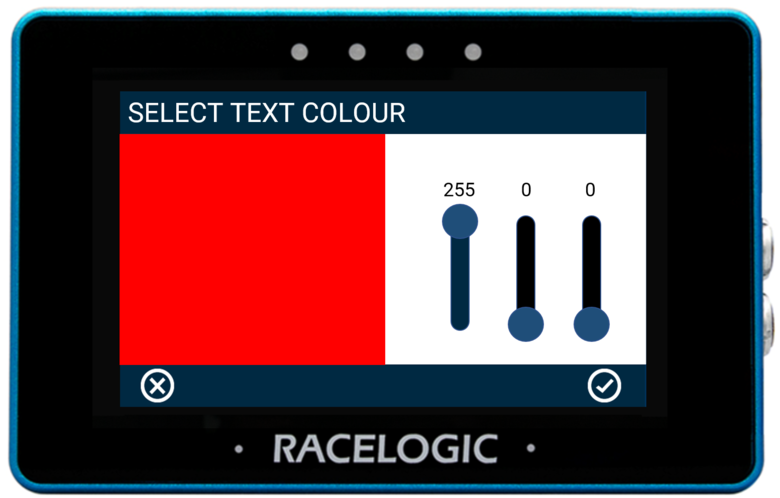 Text Colour Configuration Example |
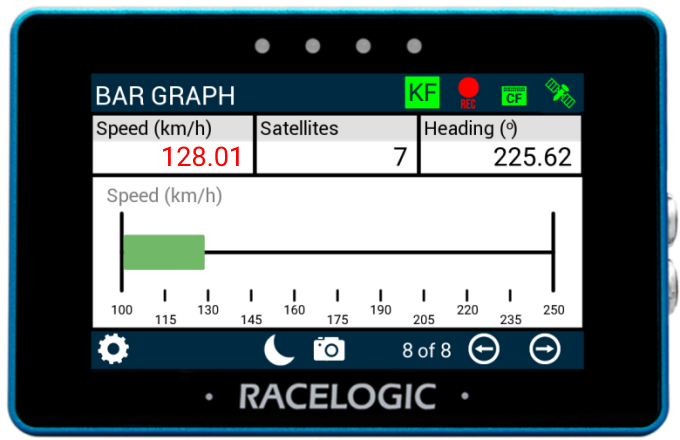 Text Colour Change Example |
To save your colour selection, press the Confirm button in the bottom right corner. Press the Cancel button in the bottom left corner to return to the Settings screen without saving.
Notes:
- A text colour change applies to the data text only, it does not apply to the parameter label.
- If you enable Night Mode, it will reset user-defined text colours.
Alerts
Condition

This option allows you to define an alert condition. Press the Select button to cycle through the available conditions: Equal To, Not Equal To, Less Than, Less Than or Equal To, Greater Than (default), Greater Than or Equal To, Between, or Not Between. You can then define the alert condition value(s) by pressing the value box and using the presented keypad.

Alert Value Keypad Example
Save your selected values by pressing the Confirm button in the bottom right corner. Press the Cancel button in the bottom left corner to return to the Settings screen without saving.
Note: The setting will be greyed out and disabled if the numerical parameter being configured is UTC Time, Longitude, or Latitude.
LED

Select to enable a solid or flashing visual alert when the Defined Alert Condition is met. Press the button to cycle through the options. The device will preview the setting with the 4 red LEDs across the top of the unit.
Note: The setting will be greyed out and disabled if the numerical parameter being configured is UTC Time, Longitude, or Latitude.
Buzzer

Select to enable an audible alert when the Defined Alert Condition is met. The MFD Touch will beep when this setting is enabled.
Note: The setting will be greyed out and disabled if the numerical parameter being configured is UTC Time, Longitude, or Latitude.
Screen
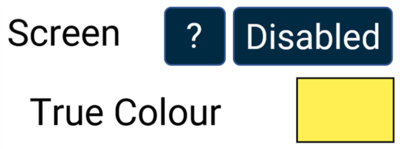
It is possible to enable a screen alert when the Defined Alert Condition is met. Once the value is achieved, the background of the parameter will change colour.
Note: The setting will be greyed out and disabled if the numerical parameter being configured is UTC Time, Longitude, or Latitude.
To change the background alert colour, press the current colour (yellow by default) and use the presented RGB sliders to define your new colour. The area to the left of the sliders provides a colour preview.
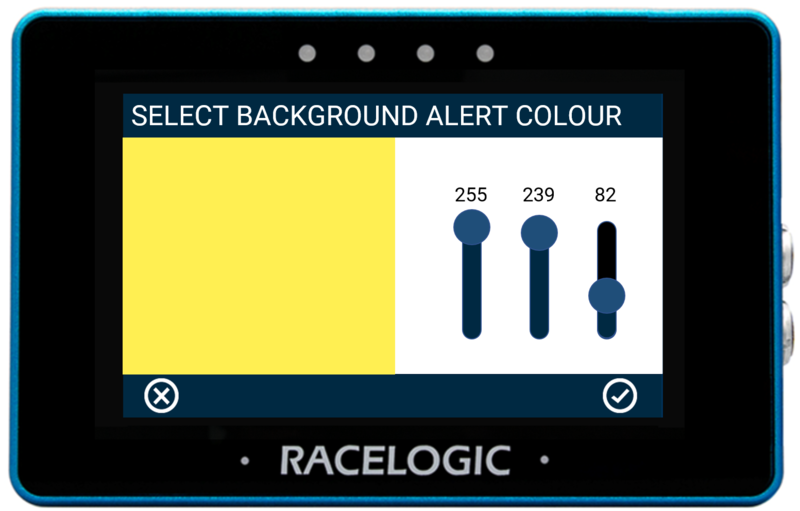 Screen Alert Colour Configuration Example |
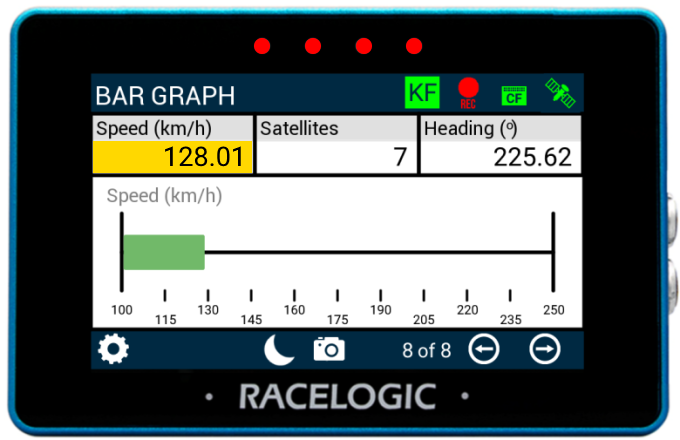 Screen Alert Example |
To save your colour selection, press the Confirm button in the bottom right corner. Press the Cancel button in the bottom left corner to return to the Settings screen without saving.
Note: If you enable Night Mode, it will reset user-defined alert colours.
